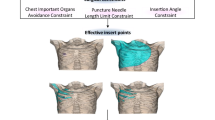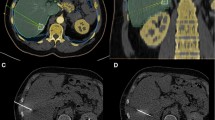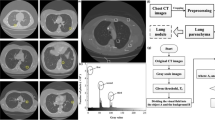Abstract
Lung cancer has is highly prevalent worldwide and is the leading cause of cancer-related deaths. In the clinic, a biopsy sample of the lesion is taken to determine whether a lung mass is benign or malignant. CT-guided percutaneous lung biopsy is a minimally invasive intervention and is commonly used to diagnose lung cancer. Path planning before surgery plays a crucial role in percutaneous lung biopsy. Traditionally, path planning for lung biopsy is performed manually by physicians based on CT images of the patient, which demands knowledge and extensive clinical experience of the operating physicians. In this work, a computer-assisted path planning system for percutaneous lung biopsy is proposed based on clinical objectives. Five constraints are presented to remove unqualified skin entry points and determine a feasible entry region based on clinical criteria. Inspired by the Pareto principle and the concept of geometric weighting, the loose-Pareto and adaptive heptagonal optimization (LPHO) method is introduced to plan the optimal puncture path. CT images of 29 patients were collected from Zigong First People’s Hospital. Retrospective experiments and test experiments were conducted to evaluate the effectiveness of the algorithm. The planning paths obtained using the proposed method were clinically feasible for 89.7% of patients, demonstrating the applicability and robustness of the system in surgical path planning for lung biopsy.
Graphical Abstract











Similar content being viewed by others
References
Liao F, Liang M, Li Z, Hu X, Song S (2019) Evaluate the malignancy of pulmonary nodules using the 3-d deep leaky noisy-or network. IEEE Trans Neural Netw Learn Syst 30(11):3484–3495. https://doi.org/10.1109/TNNLS.2019.2892409
Mukherjee J, Kar M, Chakrabarti A, Das S (2020) A soft-computing based approach towards automatic detection of pulmonary nodule. Biocybern Biomed Eng 40(3):1036–1051. https://doi.org/10.1016/j.bbe.2020.03.006
Shi Z, Hu Q, Yue Y, Wang Z, AL-Othmani OMS, Li H (2020) Automatic nodule segmentation method for CT images using aggregation-U-Net generative adversarial networks. Sens Imaging 21(1):1–16. https://doi.org/10.1007/s11220-020-00304-4
Hesamian MH, Jia W, He X, Wang Q, Kennedy PJ (2021) Synthetic CT images for semi-sequential detection and segmentation of lung nodules. Appl Intell 51(3):1616–1628. https://doi.org/10.1007/s10489-020-01914-x
Sung H, Ferlay J, Siegel RL, Laversanne M, Soerjomataram I, Jemal A, Bray F (2021) Global cancer statistics 2020: GLOBOCAN estimates of incidence and mortality worldwide for 36 cancers in 185 countries. CA: Cancer J Clin 71(3):209–249. https://doi.org/10.3322/caac.21660
Liu Z, Li Z, Zhang Y, Zhou T, Zhang J, You W, Pan K, Li W (2021) Interpretation on the report of Global Cancer Statistics 2020. J Multidiscip Cancer Manag 7(2):1–13. https://d.wanfangdata.com.cn/periodical/zlzhzldzzz202102002. Accessed 30 Apr 2021.
Siegel RL, Miller KD, Fuchs HE, Jemal A (2022) Cancer statistics, 2022. CA: Cancer J Clin. https://doi.org/10.3322/caac.21708
Yuan D, Du W, Duan X, Wang J, Ma Y, Zhang H (2017) Detection of slices including a ground-glass opacity nodule in CT volume data with semi-supervised learning. In 2017 18th IEEE/ACIS International Conference on Software Engineering, Artificial Intelligence, Networking and Parallel/Distributed Computing (SNPD) (pp. 557–561). IEEE. https://doi.org/10.1109/SNPD.2017.8022778
Turner MC, Andersen ZJ, Baccarelli A, Diver WR, Gapstur SM, Pope III CA, Prada D, Samet J, Thurston G, Cohen A (2020) Outdoor air pollution and cancer: an overview of the current evidence and public health recommendations. CA: Cancer J Clin 70(6):460–479. https://doi.org/10.3322/caac.21632.
Mu L, Liu L, Niu R, Zhao B, Shi J, Li Y, Swanson M, Scheider W, Su J, Chang SC, Yu S, Zhang ZF (2013) Indoor air pollution and risk of lung cancer among Chinese female non-smokers. Cancer Causes Control 24(3):439–450. https://doi.org/10.1007/s10552-012-0130-8
Chen S, Han Y, Lin J, Zhao X, Kong P (2020) Pulmonary nodule detection on chest radiographs using balanced convolutional neural network and classic candidate detection. Artif Intell Med 107:101881. https://doi.org/10.1016/j.artmed.2020.101881
Zhang G, Jiang S, Yang Z, Gong L, Ma X, Zhou Z, Bao C, Liu Q (2018) Automatic nodule detection for lung cancer in CT images: a review. Comput Biol Med 103:287–300. https://doi.org/10.1016/j.compbiomed.2018.10.033
Akter O, Moni MA, Islam MM, Quinn JM, Kamal AHM (2021) Lung cancer detection using enhanced segmentation accuracy. Appl Intell 51(6):3391–3404. https://doi.org/10.1007/s10489-020-02046-y
Scorza D, El Hadji S, Cortés C, Bertelsen Á, Cardinale F, Baselli G, Essert C, De Momi E (2021) Surgical planning assistance in keyhole and percutaneous surgery: a systematic review. Med Image Anal 67:101820. https://doi.org/10.1016/j.media.2020.101820
Baegert C, Villard C, Schreck P, Soler L (2007) Multi-criteria trajectory planning for hepatic radiofrequency ablation. In International conference on medical image computing and computer-assisted intervention (pp. 676–684). Springer, Berlin, Heidelberg. https://doi.org/10.1007/978-3-540-75759-7_82
Li J, Xu Y, Shen N, Feng L, Ran Z, Deng Z (2020) A practical pretreatment planning method of multiple puncturing for thermal ablation surgery. Biocybern Biomed Eng 40(4):1469–1485. https://doi.org/10.1016/j.bbe.2020.08.004
Bao N, Chen Y, Liu Y, Chakraborty C (2022a) Multi-objective path planning for lung biopsy surgery. Multimed Tools Appl 1–18. https://doi.org/10.1007/s11042-021-11476-w
Seitel A, Engel M, Sommer CM, Radeleff BA, Essert-Villard C, Baegert C, Fangerau M, Fritzsche KH, Yung K, Meinzer HP, Maier-Hein L (2011) Computer-assisted trajectory planning for percutaneous needle insertions. Med Phys 38(6Part1):3246–3259. https://doi.org/10.1118/1.3590374
Ren H, Campos-Nanez E, Yaniv Z, Banovac F, Abeledo H, Hata N, Cleary K (2014) Treatment planning and image guidance for radiofrequency ablation of large tumors. IEEE J Biomed Health Inform 18(3):920–928. https://doi.org/10.1109/JBHI.2013.2287202
Chen R, Jiang TA, Lu F, Wang K, Kong D (2017) Semiautomatic radiofrequency ablation planning based on constrained clustering process for hepatic tumors. IEEE Trans Biomed Eng 65(3):645–657. https://doi.org/10.1109/TBME.2017.2712161
Liang L, Cool D, Kakani N, Wang G, Ding H, Fenster A (2019) Automatic radiofrequency ablation planning for liver tumors with multiple constraints based on set covering. IEEE Trans Med Imaging 39(5):1459–1471. https://doi.org/10.1109/TMI.2019.2950947
Liang L, Cool D, Kakani N, Wang G, Ding H, Fenster A (2019b) Development of a multi-objective optimized planning method for microwave liver tumor ablation. In International Conference on Medical Image Computing and Computer-Assisted Intervention (pp. 110–118). Springer, Cham. https://doi.org/10.1007/978-3-030-32254-0_13
Bao N, Jia J, Chen Y, Li Z, Song C, Zhao R (2020b) Surgery path planning for lung biopsy based on pareto optimization. In 2020 International Conference on Artificial Intelligence and Communication Technology (AICT 2020). https://kns.cnki.net/KCMS/detail/detail.aspx?dbcode=IPFD&filename=JKDZ202003001054. Accessed 28 Mar 2020
Zhuang J (2017) Research on extraction of thoracic anatomy and path planning based on lung puncture surgical navigation. Northeastern University. https://kns.cnki.net/KCMS/detail/detail.aspx?dbname=CMFD201901&filename=1018076043.nh. Accessed 1 Dec 2016.
Sun F, Pei H, Yang Y, Fan Q, Li X (2022) A method of lung puncture path planning based on multi-level constraint. J Biomed Eng 39(3):462–470. https://kns.cnki.net/kcms/detail/detail.aspx?dbcode=CJFD&dbname=CJFDLAST2022&filename=SWGC202203004&uniplatform=NZKPT&v=I423DRUmglNVSYcpFcM0eAXQR65a28YseooP8cGV9seASpyz5LMXFOI6kApyoLx3. Accessed 6 Jun 2022.
Bian Z, Tan W, Liu J, Zhao D (2018) Review of anatomic segmentation methods in thoracic CT images. J Image Graphics 23(10):1450–2147. https://doi.org/10.3969/j.issn.1001-3695.2016.07.002
Ginneken BV, Baggerman W, Rikxoort EMV (2008) Robust segmentation and anatomical labeling of the airway tree from thoracic CT scans. In International Conference on Medical Image Computing and Computer-Assisted Intervention (pp. 219–226). Springer, Berlin, Heidelberg. https://doi.org/10.1007/978-3-540-85988-8_27
Van Rikxoort EM, Van Ginneken B (2013) Automated segmentation of pulmonary structures in thoracic computed tomography scans: a review. Phys Med Biol 58(17):R187. https://doi.org/10.1088/0031-9155/58/17/R187
Geng H, Tan W, Yang J, Cao P, Zhao D (2016) Survey of lung tissues segmentation based on CT image. Appl Res Comput 33(7):1929–1935. https://doi.org/10.3969/j.issn.1001-3695.2016.07.002
Qian YJ (2017) Liver vessel segmentation algorithm based on fuzzy enhance and Hessian matrix. In 2nd International Conference on Biomedical and Biological Engineering 2017 (BBE 2017) (pp. 540–545). Atlantis Press. https://doi.org/10.2991/bbe-17.2017.86
Hofmanninger J, Prayer F, Pan J, Röhrich S, Prosch H, Langs G (2020) Automatic lung segmentation in routine imaging is primarily a data diversity problem, not a methodology problem. Eur Radiol Exp 4(1):1–13. https://doi.org/10.1186/s41747-020-00173-2
Tan X, Jia Z, Wu D (1992) The use of ultrasonically guided puncture with different type of needle in diagnosing cancer. Chin J Ultrasound Med (01):10–12
Li B, Cheng ZQ, Dang G, Jin SY (2010) Survey on normal estimation for 3 D point clouds. Comput Eng Appl 46(23):1–7. https://doi.org/10.3778/j.issn.1002-8331.2010.23.001
Funding
This work was supported by the National Natural Science Foundation of China [grant numbers 61571314]; the Zigong Key Science and Technology Plan Task [2020yxy02]; and the Sichuan University-Yibin City Strategic Cooperation Special Fund Project [2020CDYB-27].
Author information
Authors and Affiliations
Contributions
Conceptualization: Qi Liu, Geyi Zhou; methodology: Qi Liu, Geyi Zhou; formal analysis and investigation: Qi Liu; writing—original draft: Geyi Zhou; data curation: Jianquan Zhong, Ling Tang, Yao Lu; validation: Jianquan Zhong, Ling Tang; writing—review and editing: Jing Qin, Ling He; funding acquisition and supervision: Jing Zhang.
Corresponding author
Ethics declarations
Competing interest
The authors declare no competing interests.
Additional information
Publisher's note
Springer Nature remains neutral with regard to jurisdictional claims in published maps and institutional affiliations.
Rights and permissions
Springer Nature or its licensor (e.g. a society or other partner) holds exclusive rights to this article under a publishing agreement with the author(s) or other rightsholder(s); author self-archiving of the accepted manuscript version of this article is solely governed by the terms of such publishing agreement and applicable law.
About this article
Cite this article
Liu, Q., Zhou, G., Zhong, J. et al. Path planning for percutaneous lung biopsy based on the loose-Pareto and adaptive heptagonal optimization method. Med Biol Eng Comput 61, 1449–1472 (2023). https://doi.org/10.1007/s11517-022-02754-2
Received:
Accepted:
Published:
Issue Date:
DOI: https://doi.org/10.1007/s11517-022-02754-2




